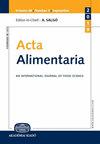样品制备对黑麦和大麦面粉面筋含量影响的研究
IF 1
4区 农林科学
Q4 FOOD SCIENCE & TECHNOLOGY
引用次数: 0
摘要
正确的面筋定量对于为乳糜泻患者提供安全的无麸质食物至关重要。然而,面筋定量面临着几个挑战:缺乏参考方法和经认证的参考材料,方法的可变性以及遗传和环境因素对面筋的影响。在所有这些挑战中,我们的研究小组专注于面筋参考材料的开发。谷蛋白含量通过酶联免疫吸附试验(ELISA)方法测定,以获得可比数据,用于选择我们参考材料开发工作中使用的品种。由于ELISA方法是为测定低面筋浓度而开发的,因此用于这些特殊研究目的需要10000倍的稀释度。以前进行的过程是提取后液体稀释,证明对小麦样品足够。然而,通过ELISA方法发现黑麦和大麦样品的面筋含量过高。其中一个原因是面筋蛋白在稀释过程中的结构和溶解度变化。因此,我们目前的研究重点是比较原始稀释方法和在无麸质基质中使用固相稀释的修订版本。本文章由计算机程序翻译,如有差异,请以英文原文为准。
Investigation of the effects of sample preparation on gluten quantitation in rye and barley flours
Proper gluten quantitation is essential for providing safe gluten-free food for patients living with celiac disease (CD). However, gluten quantitation faces several challenges: the lack of a reference method and certified reference materials, the variability of methods and the effects of genetic and environmental factors on gluten. Among all these challenges our research group focuses on gluten reference material development. Gluten content is determined by enzyme linked immunosorbent assay (ELISA) methods to obtain comparable data for the selection of cultivars used in our reference material development efforts. As ELISA methods are developed for determining low gluten concentrations, application for these special research purposes requires a 10,000-fold dilution. The formerly performed process was a post-extraction liquid dilution that proved to be sufficient for wheat samples. However, gluten contents of rye and barley samples were found to be overestimated by ELISA methods. One of the suggested reasons is the structural and solubility changes of gluten proteins during the dilution process. Therefore, our present study focuses on the comparison of the original dilution method and a revised version using solid-phase dilution in a gluten-free matrix.
求助全文
通过发布文献求助,成功后即可免费获取论文全文。
去求助
来源期刊

Acta Alimentaria
农林科学-食品科技
CiteScore
1.80
自引率
0.00%
发文量
47
审稿时长
18-36 weeks
期刊介绍:
Acta Alimentaria publishes original papers and reviews on food science (physics, physical chemistry, chemistry, analysis, biology, microbiology, enzymology, engineering, instrumentation, automation and economics of foods, food production and food technology, food quality, post-harvest treatments, food safety and nutrition).
 求助内容:
求助内容: 应助结果提醒方式:
应助结果提醒方式:


